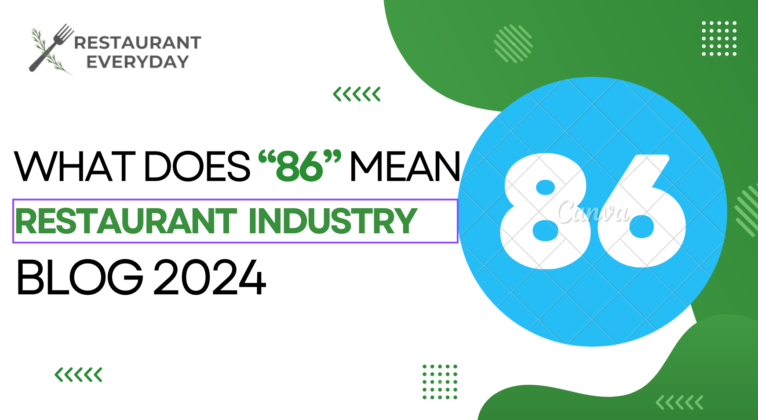Understanding the term 86 in restaurants:
In a restaurant context, “86” is used as a verb or adjective to indicate that an item on the menu is no longer available or should not be served. It can refer to running out of a specific ingredient, dish, or beverage. For example, What Does 86 Mean in a Restaurant: if a chef runs out of a particular type of fish, they might say they have “86ed” that fish, meaning it’s unavailable for ordering.
Additionally, “86” can be used more broadly to signify that something is no longer in stock, is temporarily unavailable, or should be discontinued. It’s a quick and efficient way for restaurant staff to communicate changes in inventory or menu offerings.
Origin of 86:
The term’s origin is uncertain, and various theories about its roots exist. Regardless of its origin, the use of “86” has become a common and widely understood practice in the restaurant industry.
The origin of the term “86” in the restaurant industry is not definitively known, and there are several theories about its roots. While the exact origin remains somewhat elusive, here are a few popular theories:
1. Prohibition-era speakeasies: One theory suggests that “86” originated during the Prohibition era in the United States when illegal bars or speakeasies were in operation. The term was said to be used as a code to alert patrons that they should exit the premises because law enforcement officials were on their way. The establishments would “86” the customers to let them know to leave quickly.
2. Chumley’s restaurant in New York City: Chumley’s, a historic bar and restaurant in Greenwich Village, New York City, claims to be the source of the term. It is said that there was a door at Chumley’s labeled 86 Bedford Street, and when patrons wanted to leave discreetly, they would ask to be directed to “86 Bedford” to leave without attracting attention.
3. Nautical origin: Another theory suggests a nautical origin, with the term “86” referring to the maximum depth of a ship’s hull. When a ship was in danger of sinking, it was said to be “86ed.”
4. Restaurant code: Some believe that “86” may have been part of a code used by soda jerks or restaurant staff to discreetly communicate that an item was no longer available.
Regardless of its precise origin, “86” has become ingrained in restaurant and hospitality industry jargon, widely understood as a way to communicate that something is unavailable or should be discontinued. The term has transcended its specific origin, and its usage has become a standard part of restaurant culture.
Impact on menu items and service of term 86 in the Restaurant Industry:
The term “86” significantly impacts menu items and services within the restaurant industry. Here are some key aspects of its impact:
1. Communication within the kitchen: “86” serves as a quick and efficient way for kitchen staff to communicate the depletion of specific ingredients or dishes. When a chef announces that an item is “86ed,” it signals to the rest of the kitchen staff that they should stop preparing and serving that dish.
2. Menu management: The term is crucial for menu management. It helps restaurants avoid customer disappointment by preventing orders for items that are no longer available. It also allows for real-time adjustments to the menu based on the availability of ingredients or changes in kitchen capacity.
3. Customer experience: When a server communicates to a customer that a particular menu item is “86ed,” it helps manage customer expectations. Patrons appreciate this transparency, as it prevents them from placing orders for items that cannot be fulfilled, reducing frustration and disappointment.
4. Efficient service: By promptly communicating the unavailability of certain items, the restaurant can streamline its operations. This helps optimize the workflow, preventing wasted effort in preparing dishes that cannot be served and ensuring a more efficient use of resources.
5. Flexibility in service: The ability to “86” items provides flexibility for chefs to make changes to the menu based on factors like seasonal availability of ingredients or unexpected circumstances. This adaptability is essential in dynamic culinary environments.
6. Maintaining quality: It allows the kitchen to maintain the quality and freshness of dishes. If an ingredient is no longer available or is not up to the restaurant’s standards, the decision to “86” prevents the compromise of the overall quality of the dining experience.
In summary, using “86” is crucial to effective communication and management in the restaurant industry. It helps maintain a smooth operation, ensures customer satisfaction, and allows for adaptability in response to changing circumstances.
Conclusion: What does 86 mean in a Restaurant
Using the term “86” in the restaurant industry allows for notable flexibility in responding to changing circumstances. Here’s an exploration of how this flexibility manifests:
1. Adaptability in Menu Offerings:
– In unforeseen circumstances, such as ingredient shortages or supplier issues, restaurants can quickly and seamlessly adapt their menus.
– The ability to “86” certain items allows chefs and kitchen staff to make real-time decisions, offering alternative dishes that utilize available ingredients.
2. Seasonal Changes:
– Certain ingredients may become unavailable or fall out of season in seasonal or dynamic culinary environments.
– “86” empowers restaurants to swiftly adjust their offerings, ensuring that menus remain fresh, relevant, and aligned with the availability of seasonal produce.
3. Managing Kitchen Capacity:
– During peak hours or unexpected rushes, the kitchen may reach capacity for certain dishes.
– By declaring “86” on specific items, the kitchen can control the influx of orders, preventing delays and ensuring the timely preparation and delivery of other menu items.
4. Quality Assurance:
– If the quality of a particular ingredient does not meet the restaurant’s standards, declaring “86” on that ingredient prevents the compromise of overall dish quality.
– This flexibility ensures that only the freshest and highest-quality ingredients are used in preparing meals.
5. Responding to Dietary Restrictions:
– “86” is a valuable tool for accommodating dietary restrictions or preferences.
– When a customer specifies dietary needs, staff can readily communicate the availability of suitable options and modify orders accordingly.
6. Operational Efficiency:
– By promptly communicating the unavailability of certain items, the restaurant can optimize workflow and reduce wasted effort in preparing dishes that cannot be served.
– This efficiency contributes to a smoother operation, enhancing the overall dining experience for customers.
What Does 86 Mean in a Restaurant Industry 2024: the term “86” has become a dynamic and adaptable tool in the restaurant industry, reflecting the ever-changing nature of culinary establishments. Its use has transcended its original uncertain origins, becoming an integral part of the language and culture of the hospitality business. The ongoing use and understanding of “86” demonstrate how language and terminology within specific industries can evolve and take on new meanings over time.




